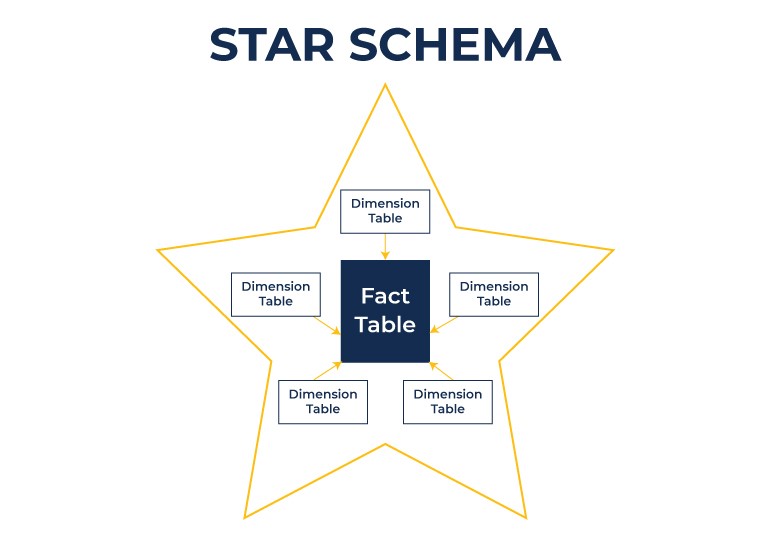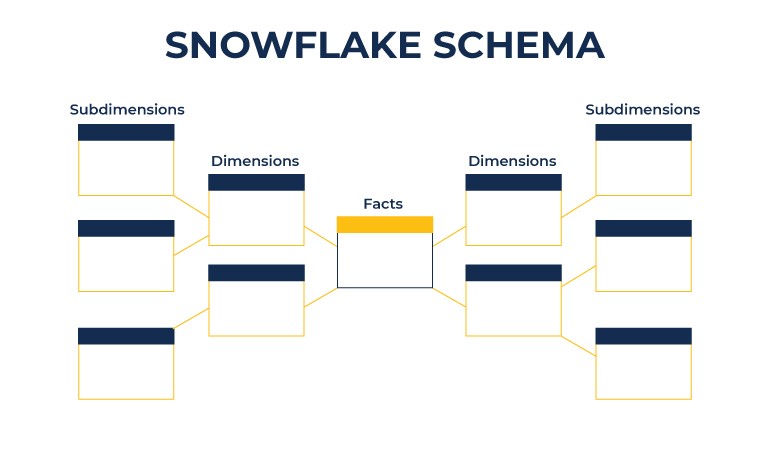In today’s data-driven world, businesses rely heavily on data to make informed decisions and gain a competitive edge. However certain factors ensure data-driven decision-making in an organization, and a well-designed data warehouse is one of them.
Every business needs a well-designed data warehouse, capable of storing and retrieving data efficiently, to manage and analyze large volumes of data. Schema design is a crucial component of a data warehouse; it determines how your data warehouse organizes and stores the data. Today we will talk about the star vs snowflake schema.
The two most popular schema designs are the star schema and the snowflake schema, each with its strengths and weaknesses. Choosing the right schema design depends on your specific business requirements. Star vs snowflake schema establishes the basis for insightful and informed decision-making.
This article explores the star vs. snowflake schemas in Data analytics solutions. It also talks about which schema you should use when and why. Before we get into the star vs snowflake schema debate, let’s discuss each individually.
Star Schema
The star schema is a simple design that has a central fact table surrounded by one or more dimension tables. The fact table contains the measures or metrics, and the dimension tables contain the attributes that describe the fact table. The fact table and dimension tables are joined on the primary key of the dimension table. It stores data in a star format, hence the name star schema.

One of the primary advantages of the star schema is its simplicity. It is easy to understand and use, which makes it ideal for small to medium-sized businesses. A data warehouse with a star schema also has faster query performance since it involves fewer joins. Moreover, the star schema is denormalized, which means that data analytics is duplicated across the dimension tables, resulting in faster data retrieval. Now let’s learn about the snowflake scheme before moving on to the star vs snowflake schema.
Snowflake Schema
The snowflake schema has a more complex design than the star schema. It is a normalized schema that has a central fact table surrounded by dimension tables in a snowflake schema. However, the dimension tables are further normalized into sub-dimension tables.

One of the biggest advantages of the snowflake schema is its flexibility. It allows for more detailed data analysis and supports complex business models. Additionally, it allows for better data integrity since it eliminates data redundancy. The snowflake schema is also more scalable, as you can add new dimensions without affecting existing tables.
Difference Between Star Schema and Snowflake Schema
Here’s a diagram explaining the star vs. snowflake schemas.
Factors to Consider When Choosing a Schema
The choice between the star schema and the snowflake schema ultimately depends on your unique business needs. You should consider several factors in star schema vs snowflake schema to ensure that the chosen schema meets your requirements and helps you achieve your business goals.
Here are some of the most significant factors when it comes to snowflake vs star schema that you should consider when choosing the type of schema for your data warehouse. The following factors will help us settle the star vs snowflake schema debate.
Data Complexity
The difference between star schema and snowflake schema could be judged based on data complexity. The level of complexity of the data being analyzed is an essential factor to consider when selecting a schema in snowflake schema vs star schema. A star schema is best suited for simple data, while a snowflake schema is ideal for more complex and granular data.
The star schema is usually associated with a denormalized data structure in comparison to the snowflake schema. It is mostly well-suited for situations involving fast query performance. Star schema works amazingly well for simple data analysis as well. However, the snowflake schema is characterized by a normalized data structure and works well in maintaining data integrity. It reduces redundancy.
Number of Dimensions
The number of dimensions in the data is another critical factor to consider for star schema vs snowflake.. A star schema works best for data with a limited number of dimensions, while a snowflake schema is more appropriate for data with a larger number of dimensions.
Reporting Needs
For star schema and snowflake schema, You should also take into account the specific reporting needs of your business when selecting a schema. A star schema is ideal for simple reporting requirements where performance is a critical factor, while a snowflake schema is more appropriate for complex reporting requirements that require more data and more flexible data modeling.
Query Performance
Query performance is another significant factor one should consider when selecting a schema. A star schema typically provides better query performance since it requires fewer table joins. On the other hand, a snowflake schema may have slower query performance due to its more complex table structure.
Data Modeling Flexibility
Data modeling flexibility is also a crucial consideration when deciding which schema type to go with. A snowflake schema provides more flexibility in data modeling since it allows for more normalization and separation of data, while a star schema provides less flexibility but is easier to understand and implement.
Conclusion
To sum it up, there is no one-size-fits-all solution when it comes to data modeling, and choosing the right schema design depends on various factors, such as the size of the data, the reporting requirements, and the complexity of the data. The star vs snowflake schema debate could be a challenge to settle.
Therefore, we recommend that you consult with a data modeling expert to determine the best schema design for a specific data warehouse or analytics project.
At Xavor, we use the latest tools and technologies like BigQuery, Snowflake, and Redshift to design and implement data models that are optimized for performance, flexibility, and scalability. Our experienced team helps you design a data model that meets your specific business requirements and enables you to make data-driven, informed decisions.
Still not sure about Star vs. Snowflake? Drop us a line at [email protected] to book a FREE consultation session with our BI & Data Analytics team to learn how Xavor can help you build a data warehouse that provides efficient and effective data analysis tools.
FAQs
The star schema is a database design where a central fact table is connected to one or more dimension tables, forming a star-like structure. It is known for its simplicity and is suitable for small to medium-sized businesses.
The snowflake schema is a normalized database design that extends the star schema by further normalizing dimension tables into sub-dimension tables. It offers more flexibility and supports complex data analysis compared to the star schema.
Choosing a star schema when dealing with simple data, limited dimensions, and fast query performance is crucial. It’s well-suited for situations where data redundancy and denormalization are acceptable.
Opt for a snowflake schema when dealing with complex and granular data, a larger number of dimensions, and a need for better data integrity. It allows for more detailed data analysis and supports complex business models.
Star schema typically provides better query performance as it involves fewer table joins. On the other hand, snowflake schema may experience slower query performance due to its more complex table structure.
Consulting with a data modeling expert is recommended as they can assess specific project requirements, considering factors like data size, reporting needs, and complexity. They can provide tailored advice on whether a star or snowflake schema is more suitable.













